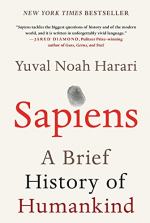
|
| Name: _________________________ | Period: ___________________ |
This test consists of 15 multiple choice questions and 5 short answer questions.
Multiple Choice Questions
1. What does Harari assert is the key to understanding a particular culture?
(a) Understanding that all cultures embrace a form of power structure.
(b) Understanding that all cultures embrace a sense of unity.
(c) Understanding that all cultures embrace internal contradictions.
(d) Understanding that all cultures embrace specific jargon.
2. The Aztec Empire ruled how many different tribes and peoples?
(a) 371.
(b) 276.
(c) 189.
(d) 48.
3. What does Harari NOT list among the "premodern traditions of knowledge" he discusses?
(a) Buddhism.
(b) Confucianism.
(c) Christianity.
(d) Scientology.
4. Harari states that money is based on what two universal principles?
(a) Convertibility and trust.
(b) Sovereignty and intrinsic value.
(c) Negotiability and convertibility.
(d) Trust and sovereignty.
5. Who wrote The Mathematical Principles of Natural Philosophy?
(a) Leonardo da Vinci.
(b) Isaac Newton.
(c) Plato.
(d) Albert Einstein.
6. Harari asserts that "an empire is defined solely by its" (190) what?
(a) The size of its population.
(b) Cultural diversity and flexible borders.
(c) Its form of government.
(d) Its territorial extent.
7. How many years did the journey take when Magellan circumnavigated the earth for the first time?
(a) Five.
(b) Three.
(c) Six.
(d) Two.
8. When stating that "modern science differs from all previous traditions of knowledge in three major ways" (250), Harari states that one quality of modern science is "its centrality of observation" (251) and its centrality of what other element?
(a) Survival.
(b) Mathematics.
(c) Philosophy.
(d) Logic.
9. The Australian World comprised which parts of earth in 1450 AD?
(a) Most of western South America.
(b) Australia and eastern Asia.
(c) Most of Central America and parts of North America.
(d) Only the continent of Australia.
10. Which "world" (168) "swallowed up all of the other worlds" (168) within a span of 300 years?
(a) The Afro-Asian world.
(b) The Mesoamerican world.
(c) The Aztec world.
(d) The Andean world.
11. Harari asserts that observation is not what?
(a) Certainty.
(b) Religion.
(c) Knowledge.
(d) Incontrovertible proof.
12. In what year did Hernan Cortes and his conquistadors invade Mexico?
(a) 1592.
(b) 1501.
(c) 1498.
(d) 1519.
13. The Aztec Empire at its pinnacle was much smaller than what modern-day nation?
(a) Peru.
(b) Greece.
(c) New Zealand.
(d) Mexico.
14. The measurement called a sila was equivalent to how many gallons?
(a) One gallon.
(b) A half a gallon.
(c) A quarter of a gallon.
(d) Two gallons.
15. Biological poverty is defined by Harari as what?
(a) A state that occurs when a person has been kept in quarantined conditions for too long.
(b) A state that endanger's a person's life due to a lack of food and shelter.
(c) A state that withholds from a person opportunities that are available to others.
(d) A state that occurs when a person experiences a sudden loss of health.
Short Answer Questions
1. The total value of goods and services produced by humans in the year 1500 was how much in 2015 money?
2. Harari asserts that "Until the Scientific Revolution most human cultures did not believe in" (264) what?
3. Harari states that the leading project of what revolution is to give humankind eternal life?
4. Harari asserts that the last 500 years have demonstrated an "unprecedented growth in human" (248) what?
5. The Andean World comprised which parts of earth in 1450 AD?
|
This section contains 512 words (approx. 2 pages at 300 words per page) |

|




